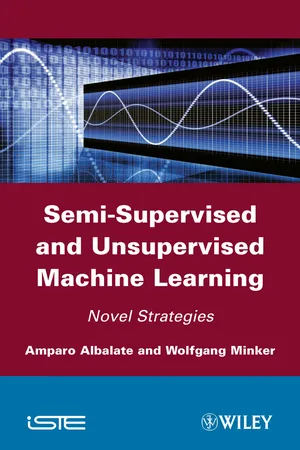![]()
PART 1
State of the Art
![]()
Chapter 1
Introduction
The main objective of this book is to develop machine learning (ML) tools that help minimize the (costly) human supervision required for the analysis of large volumes of data. To address such an objective, the research work developed in this book focused on two major fields in ML: unsupervised and semi-supervised learning. Both ML areas have been widely used in a large number of applications such as the clustering and semi-automatic annotation of large datasets of documents and the dimensionality reduction of microarray matrices for the analysis and interpretation of genomic data. In these examples, owing to the complexity and/or size of the large amounts of data to be processed, a fully supervised analysis without the help of semi- or unsupervised ML tools would become prohibitive.
Thus, the first aim of this book focused on the development of new algorithms in the field of semi-supervised ML. Semi-supervised learning provides an alternative to fully supervised classification. In supervised classification, a so-called training phase is performed using only labeled data. Typically, the labels for the training observations are manually compiled by human annotators. Then, a supervised algorithm is capable of inferring prediction rules or models from the available training data and consequently delivering the most probable label for a new observation, not necessarily observed in the training data. However, a major limitation of supervised algorithms is related to the availability of large corpora labeled in order to achieve accurate predictions. As it is generally accepted in the ML literature, the performance of supervised classifiers can drastically drop down if only training sets of small dimensions are available.
In [CAS 95] it was shown that some advantage could be, however, gained if a large amount of unlabeled data is available. In particular, this is possible to the degree to which class labels fulfill certain assumptions that allow us to identify the class structure from both labeled and unlabeled data. The framework of classification algorithms designed to use both labeled and unlabeled data to generate their prediction models is known as semi-supervised classification.
Nowadays, the semi-supervised learning field is rapidly evolving, as evidenced by the large amount of semi-supervised approaches available in the machine learning literature, including generative models, co-training, self-training, and graph-based models etc. Frequently, the learning strategy followed by many semi-supervised algorithms can be summarized as follows: (1) select a supervised algorithm with a certain learning rule for labeled data and (2) modify the learning rule by including unlabeled data so that a common objective is attained. A drawback of such a strategy is the algorithms’ stability/robustness with respect to the existence of labeling errors. Given the human effort involved in the manual labeling task, training sets are not exempted from potential labeling errors. These may occur depending on the degree of expertise of the human annotators. Even for expert labelers, the confidence in annotating patterns with a certain degree of ambiguity may drop drastically. Hence, a subjective bias in annotating this kind of pattern is unavoidable. Depending on the nature of the classification task and corpora, subjective biases may become a commonly faced problem, as happens in the recognition of emotional states.
Given the aforementioned statement, in this book two different approaches to semi-supervised classification are described which rely on unsupervised clustering as a prior step to classification. By clearly separating the clustering and classification objectives, the proposed algorithms may gain some robustness under labeling errors with respect to other existing semi-supervised algorithms. The first algorithm has been developed for utterance corpora. It exploits the semantic feature variability by means of prior feature clustering, which is combined with a “fully unsupervised” algorithm for pattern disambiguation. The second approach performs the clustering in the pattern space to extract the underlying class structure and uses the labeled sets to automatically annotate the clusters.
The second aim of this book is to identify the underlying classes in a dataset in a fully unsupervised way, i.e. under the absence of labels. The field of unsupervised learning has witnessed an accelerated growth since the mid-1940s (see Chapter 2 for detail information), resulting in a large pool of clustering algorithms in the ML literature. However, the first question that arose with the use of a clustering algorithm is the optimum number of clusters to be selected. Most clustering algorithms are parametric approaches, which may explicitly require the number of clusters k as an input parameter, or implicitly, other types of parameters that also require...
